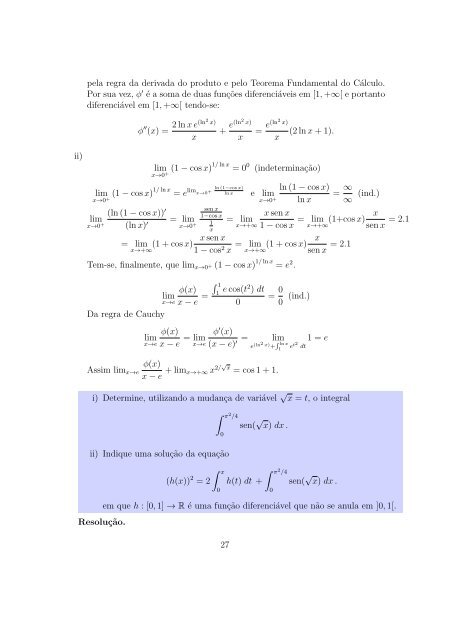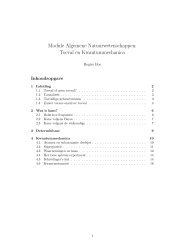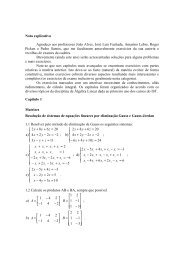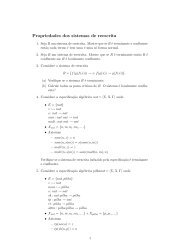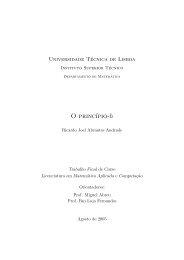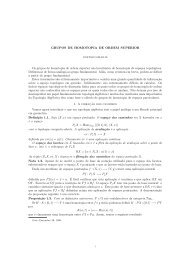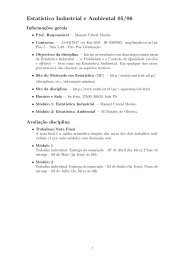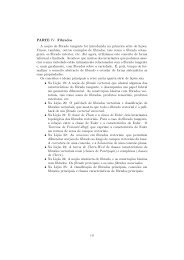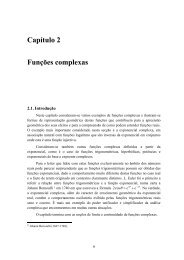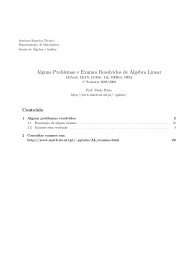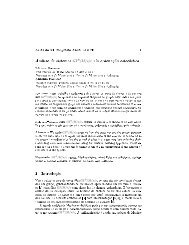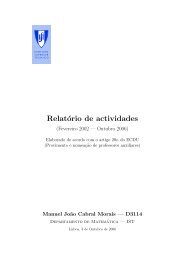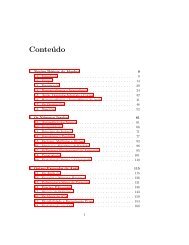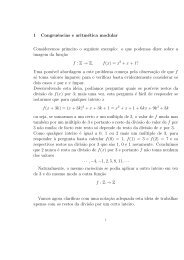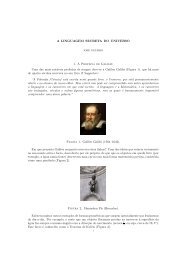Exercícios de Cálculo Integral e Diferencial I
Exercícios de Cálculo Integral e Diferencial I
Exercícios de Cálculo Integral e Diferencial I
Create successful ePaper yourself
Turn your PDF publications into a flip-book with our unique Google optimized e-Paper software.
ii)<br />
pela regra da <strong>de</strong>rivada do produto e pelo Teorema Fundamental do <strong>Cálculo</strong>.<br />
Por sua vez, φ ′ é a soma <strong>de</strong> duas funções diferenciáveis em [1, +∞[ e portanto<br />
diferenciável em [1, +∞[ tendo-se:<br />
φ ′′ (x) = 2 ln x e(ln2 x)<br />
x<br />
+ e(ln2 x)<br />
x = e(ln2 x)<br />
(2 ln x + 1).<br />
x<br />
lim<br />
x→0 + (1 − cos x)1/ ln x = 0 0 (in<strong>de</strong>terminação)<br />
lim<br />
x→0 + (1 − cos x)1/ ln x = e lim ln (1−cos x)<br />
x→0 + ln x e lim<br />
x→0 +<br />
ln (1 − cos x)<br />
lim<br />
x→0 +<br />
(ln (1 − cos x)) ′<br />
(ln x) ′<br />
= lim<br />
x→0 +<br />
sen x<br />
1−cos x<br />
1<br />
x<br />
x sen x<br />
= lim (1 + cos x)<br />
x→+∞ 1 − cos2 x<br />
x sen x<br />
= lim<br />
x→+∞ 1 − cos x<br />
ln x<br />
x<br />
= lim (1 + cos x)<br />
x→+∞ sen x<br />
Tem-se, finalmente, que limx→0 + (1 − cos x)1/ ln x = e 2 .<br />
φ(x)<br />
lim<br />
x→e x − e =<br />
Da regra <strong>de</strong> Cauchy<br />
Assim limx→e<br />
φ(x)<br />
lim<br />
x→e x − e<br />
= lim<br />
x→e<br />
1<br />
1 e cos(t2 ) dt<br />
0<br />
φ ′ (x)<br />
(x − e)<br />
′ = lim<br />
= 0<br />
0 (ind.)<br />
e (ln2 <br />
x) ln x<br />
+ 1<br />
φ(x)<br />
x − e + limx→+∞ x 2/√ x = cos 1 + 1.<br />
= ∞<br />
∞ (ind.)<br />
x<br />
= lim (1+cos x)<br />
x→+∞ sen x<br />
et2 1 = e<br />
dt<br />
= 2.1<br />
i) Determine, utilizando a mudança <strong>de</strong> variável √ x = t, o integral<br />
π 2 /4<br />
ii) Indique uma solução da equação<br />
Resolução.<br />
(h(x)) 2 = 2<br />
0<br />
x<br />
0<br />
sen( √ x) dx .<br />
h(t) dt +<br />
π 2 /4<br />
0<br />
sen( √ x) dx .<br />
em que h : [0, 1] → R é uma função diferenciável que não se anula em ]0, 1[.<br />
27<br />
= 2.1


